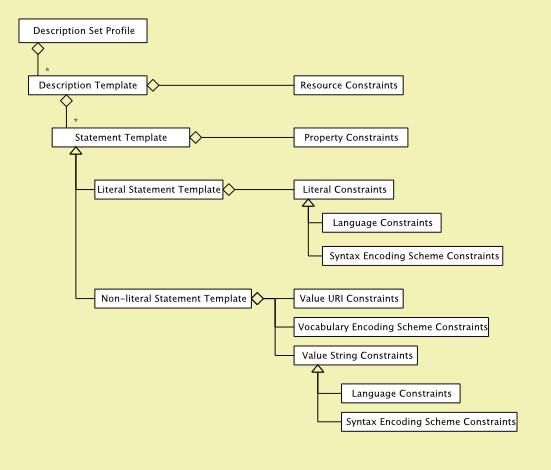DC Application Profile
This page is to summarize the DCMI specifications and concepts of DC Metadata profiles and howto create them.
DCMI Description Set Profile[edit]
Resources, properties and values are given in a Description set which can be defined in a Description Set Profile (DSP). A Description Set Profile (DSP) basically consists of Templates and Constraints. Templates are to express structures and Constraints limit those structures. The following graphic from DCMI shows the basic structure of a DSP:
Templates[edit]
In the left part of the graphic all kinds of Templates are given. Templates describing
- resources (Description Template)
- statements or properties (Statement Template, Literal Statement Template, Non-literal Statement Template)
Constraints[edit]
The right part of the graphic shows the different kinds of constraints that can occur in a DSP.
Constraints are used to define limitations on
- resources e.g. only resources of type foaf:person are allowed (Resource Constraints)
- properties e.g. a person has a property called foaf:name (Property Constraints)
- two ways: giving an explicit list of allowed properties, requiring the property to be a sub-property of a given property
- values e.g. the value of a special property must be a Literal (kinds of Literal Constraints, Value Constraints and Vocabulary Encoding Schemes)
Definitions[edit]
Resourse
Statement
Literal An entity which uses a Unicode string as a lexical form, together with an optional language tag or datatype, to denote a resource (i.e. "literal" as defined by RDF [RDF].
Dublin Core Abstract Model A generic syntax for metadata records.
DCMI Application Profile (DCAP)[edit]
Different application have different metadata needs and use several formats and vocabularies. But there is also the need to provide metadata across applications and semantic interoperability. The Dublin Core Metadata Initiative has addressed this by providing a framework for designing a Dublin Core Application Profile (DCAP) that meets specific application needs while providing semantic interoperability with other applications on the basis of globally defined vocabularies and models (DCMI Profile Guidelines).
Advantage: DCAP is generic and you can use it with any metadata terms that are defined in accordance with the RDF.
Framework for DCAP[edit]
A DCAP is a description and specification of the metadata used in a particular application. It consists of one or more documents and contains: * Functional Requirements of the application (what it does) * Domain Model - types of things that are described my metadata and relationships * Description Set Profile and Usage Guideline - catalogue with metdata terms and rules for usage (constraints) * Syntax Guidelines and Data Formats - which syntax/format is used to encode the data
